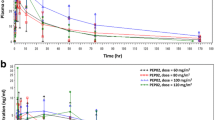Abstract
Purpose
ATI-1123 is a liposomal formulation of docetaxel and may be administered without the premedications and hypersensitivity reactions. This Phase I study examines the safety, tolerability, pharmacokinetics (PKs), and antitumor activity of ATI-1123.
Methods
Patients with advanced solid malignancies received escalating doses of ATI-1123 intravenously over 1-h every 3 weeks. The dosing commenced using an accelerated titration design and was followed by a modified 3 + 3 Fibonacci schema to determine maximally tolerated dose (MTD). Plasma was analyzed for encapsulated/non-encapsulated docetaxel; PK analyses were performed using model independent method. Response was assessed using RECIST criteria.
Results
In total, 29 patients received doses ranging from 15 to 110 mg/m2. At 110 mg/m2, two of six patients experienced dose-limiting toxicities including grade 3 stomatitis and febrile neutropenia. The 90 mg/m2 cohort was expanded to ten patients and identified as the MTD. The most common adverse events were fatigue, nausea, neutropenia, anemia, anorexia, and diarrhea. ATI-1123 exhibited linear and dose proportional PKs. One patient with lung cancer had confirmed partial response, and stable disease was observed in 75 % patients.
Conclusions
ATI-1123 demonstrated an acceptable tolerability and favorable PK profile in patients with solid tumors. Our results provide support for Phase II trials to determine the antitumor activity of this drug.


Similar content being viewed by others
References
Dumontet C, Sikic BI (1999) Mechanisms of action of and resistance to anti-tubulin agents: microtubule dynamics, drug transport, and cell death. J Clin Oncol 17(3):1061–1070
Ajani JA, Moiseyenko VM, Tjulandin S, Majlis A, Constenla M, Boni C, Rodrigues A, Fodor M, Chao Y, Voznyi E, Marabotti C, Van Cutsem E (2007) Clinical benefit with docetaxel plus fluorouracil and cisplatin compared with cisplatin and fluorouracil in a phase III trial of advanced gastric or gastroesophageal cancer adenocarcinoma: the V-325 Study Group. J Clin Oncol 25(22):3205–3209. doi:10.1200/jco.2006.10.4968
Blohmer JU, Schmid P, Hilfrich J, Friese K, Kleine-Tebbe A, Koelbl H, Sommer H, Morack G, Wischnewsky MB, Lichtenegger W, Kuemmel S (2010) Epirubicin and cyclophosphamide versus epirubicin and docetaxel as first-line therapy for women with metastatic breast cancer: final results of a randomised phase III trial. Ann Oncol 21(7):1430–1435. doi:10.1093/annonc/mdp585
Burstein HJ, Manola J, Younger J, Parker LM, Bunnell CA, Scheib R, Matulonis UA, Garber JE, Clarke KD, Shulman LN, Winer EP (2000) Docetaxel administered on a weekly basis for metastatic breast cancer. J Clin Oncol 18(6):1212–1219
Taxotere (docetaxel) injection concentrate. Full prescribing information 2013
Rivera E, Mejia JA, Arun BK, Adinin RB, Walters RS, Brewster A, Broglio KR, Yin G, Esmaeli B, Hortobagyi GN, Valero V (2008) Phase 3 study comparing the use of docetaxel on an every-3-week versus weekly schedule in the treatment of metastatic breast cancer. Cancer 112(7):1455–1461. doi:10.1002/cncr.23321
Drummond DC, Meyer O, Hong K, Kirpotin DB, Papahadjopoulos D (1999) Optimizing liposomes for delivery of chemotherapeutic agents to solid tumors. Pharmacol Rev 51(4):691–743
Immordino ML, Dosio F, Cattel L (2006) Stealth liposomes: review of the basic science, rationale, and clinical applications, existing and potential. Int J Nanomed 1(3):297–315
Klamerus KJ, Maloney K, Rudolph RL, Sisenwine SF, Jusko WJ, Chiang ST (1992) Introduction of a composite parameter to the pharmacokinetics of venlafaxine and its active O-desmethyl metabolite. J Clin Pharmacol 32(8):716–724
Gough K, Hutchison M, Keene O, Byrom B, Ellis S, Lacey L, McKellar J (1995) Assessment of dose proportionality: report from the statisticians in the pharmaceutical industry/pharmacokinetics UK joint working party. Drug Inf J 29:1039–1048
Smith TJ, Khatcheressian J, Lyman GH, Ozer H, Armitage JO, Balducci L, Bennett CL, Cantor SB, Crawford J, Cross SJ, Demetri G, Desch CE, Pizzo PA, Schiffer CA, Schwartzberg L, Somerfield MR, Somlo G, Wade JC, Wade JL, Winn RJ, Wozniak AJ, Wolff AC (2006) 2006 update of recommendations for the use of white blood cell growth factors: an evidence-based clinical practice guideline. J Clin Oncol 24(19):3187–3205. doi:10.1200/jco.2006.06.4451
Loos WJ, Baker SD, Verweij J, Boonstra JG, Sparreboom A (2003) Clinical pharmacokinetics of unbound docetaxel: role of polysorbate 80 and serum proteins. Clin Pharmacol Therm 74(4):364–371. doi:10.1016/s0009-9236(03)00222-4
Bruno R, Riva A, Hille D et al (1997) Pharmacokinetic and pharmacodynamic properties of docetaxel: results of phase I and phase II trials. Am J Health Syst Pharm 54(24 Suppl 2):S16–S19
Hilkens PH, Verweij J, Stoter G, Vecht CJ, van Putten WL, van den Bent MJ (1996) Peripheral neurotoxicity induced by docetaxel. Neurology 46(1):104–108
Behar A, Pujade-Lauraine E, Maurel A, Brun MD, Chauvin FF, Feuilhade de Chauvin F, Oulid-Aissa D, Hille D (1997) The pathophysiological mechanism of fluid retention in advanced cancer patients treated with docetaxel, but not receiving corticosteroid comedication. Br J Clin Pharmacol 43(6):653–658
Deeken JF, Slack R, Weiss GJ, Ramanathan RK, Pishvaian MJ, Hwang J, Lewandowski K, Subramaniam D, He AR, Cotarla I, Rahman A, Marshall JL (2013) A phase I study of liposomal-encapsulated docetaxel (LE-DT) in patients with advanced solid tumor malignancies. Cancer Chemother Pharmacol 71(3):627–633. doi:10.1007/s00280-012-2048-y
Bruno R, Hille D, Riva A et al (1998) Population pharmacokinetics/pharmacodynamics of docetaxel in phase II studies in patients with cancer. J Clin Oncol 16(1):187–196
Acknowledgments
The authors wish to express their deep appreciation to Ms. Susan Beardslee for reviewing the manuscript and providing very valuable comments. This study was sponsored by Azaya Therapeutics.
Conflict of interest
None to declare.
Author information
Authors and Affiliations
Corresponding author
Rights and permissions
About this article
Cite this article
Mahalingam, D., Nemunaitis, J.J., Malik, L. et al. Phase I study of intravenously administered ATI-1123, a liposomal docetaxel formulation in patients with advanced solid tumors. Cancer Chemother Pharmacol 74, 1241–1250 (2014). https://doi.org/10.1007/s00280-014-2602-x
Received:
Accepted:
Published:
Issue Date:
DOI: https://doi.org/10.1007/s00280-014-2602-x




